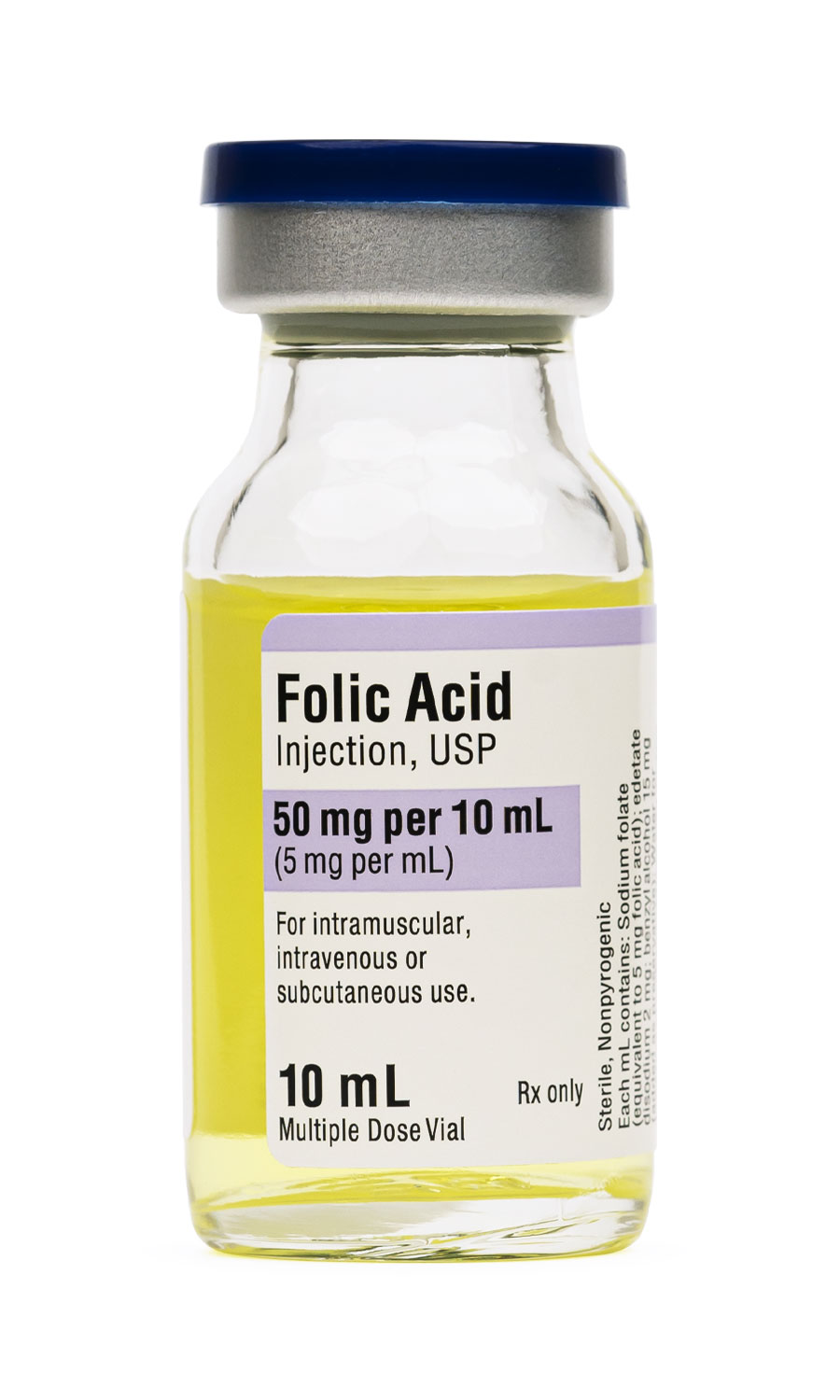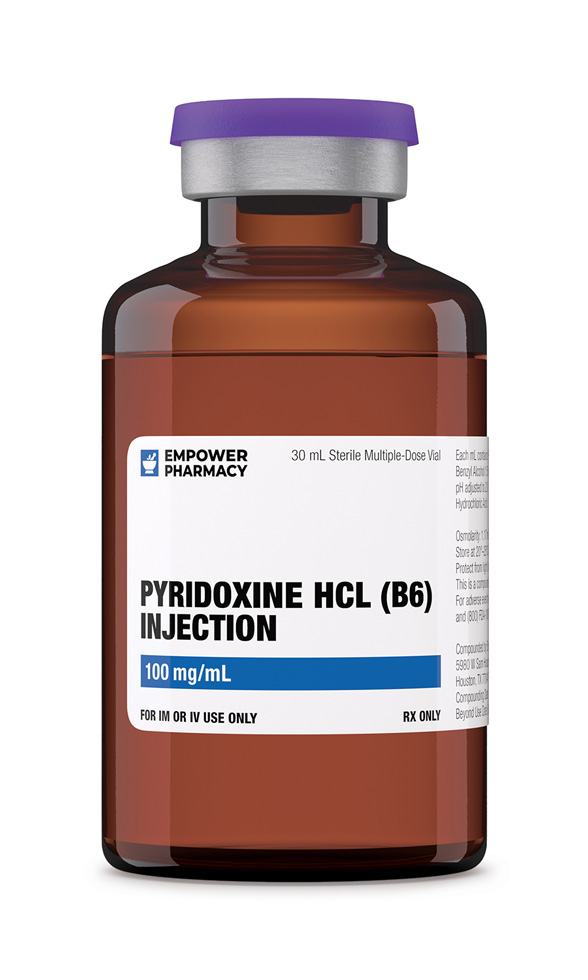Overview of Folic Acid (Vitamin B9) Injection
-
Dosage Strength of Folic Acid (Vitamin B9) Injection
-
Folic Acid (Vitamin B9) Injection: 10 mg/mL 30 mL Vial
Folic Acid (Vitamin B9) Injection: 5 mg/mL 10 mL Vial † -
General Information
-
Folic acid is a water-soluble, B-complex vitamin that is available orally and parenterally. This vitamin is found in a variety of foods including liver, kidneys, yeast, and leafy, green vegetables. A deficiency in folic acid can cause a variety of hematologic complications including megaloblastic and macrocytic anemias. In addition to treating megaloblastic and macrocytic anemias as well as tropical sprue, this vitamin is also used as a diagnostic aid for folate deficiency. In recent years, it has been discovered that adequate folic acid intake can substantially decrease the risk of congenital neural tube defects.1 Unlike the folic acid derivative leucovorin, folic acid is not clinically useful in offsetting the action of folate reductase inhibitors because it requires the enzyme dihydrofolate reductase for activation. Folic acid is also ineffective in the treatment of aplastic and normocytic anemias. Prescription forms of folic acid were approved by the FDA in 1946. In 1998, the recommended dietary allowance for all women of child bearing age who are capable of becoming pregnant was increased to 400 mcg of folic acid daily. As of 1998, the FDA has required that all food manufacturers fortify enriched grain products with folic acid to reduce the risk of congenital neural tube defects.
-
Mechanism of Action
-
Folic acid, a biochemically inactive compound, is the precursor for tetrahydrofolic acid and methyltetrahydrofolate. Tetrahydrofolic acid, methyltetrahydrofolate, and other folic acid congeners are essential for the maintenance of normal erythropoiesis and are also required cofactors for the synthesis of purine and thymidylate nucleic acids. They are also necessary for the interconversion of amino acids such as the metabolism of histidine to glutamic acid and the interconversion of serine and glycine. Folic acid congeners are transported across cells by receptor-mediated endocytosis where they function and are stored. Other processes involving folate coenzymes include generation and use of formate and methylation of transfer RNA. Impaired thymidylate synthesis, which leads to faulty DNA synthesis, is responsible for megaloblastic and macrocytic anemias.
An important role of folic acid is the formation of methionine from homocysteine using vitamin B12 as a cofactor. Adequate folic acid intakes can normalize high homocysteine levels via increased remethylation of homocysteine to methionine via 5-methyltetrahydrofolate-homocysteine methyltransferase (a.k.a.; methionine synthetase). Reduced folic acid intake is associated with hyperhomocysteinemia. Hyperhomocysteinemia is recognized as an independent risk factor for artherosclerosis of the coronary, cerebral, and peripheral vasculature. There is mounting evidence that elevated plasma homocysteine (and therefore decreased serum methionine) contributes to congenital neural tube defects. High serum homocysteine levels may also be important in the pathogenesis of colon cancer, diabetic retinopathy, and other diseases. -
Pharmacokinetics
-
Folic acid is administered orally and parenterally. Folic acid congeners are extensively bound to plasma proteins and are distributed throughout the body including the CSF. They also appear in breast milk. After administration of small doses, reduction and methylation of folic acid to methyltetrahydrofolate occurs in the liver. Following large doses, folic acid may appear unchanged in the plasma. Active forms of folic acid are reabsorbed through enterohepatic recirculation. Folic acid is eliminated primarily renally as metabolites. When body stores become saturated, excess folic acid is excreted unchanged in the urine.
-
Contraindications/Precautions
-
Folic acid is contraindicated for use in patients with folic acid hypersensitivity.
Folic acid should be used with extreme caution in patients with undiagnosed anemia. Folic acid corrects the hematologic manifestations of pernicious anemia, while the neurologic complications progress, potentially causing irreversible central nervous system effects. Doses greater than 0.4 mg/day should be avoided until the diagnosis of pernicious anemia is ruled out.
Many formulations of folic acid injection contain benzyl alcohol as a preservative. Benzyl alcohol may cause allergic reactions. Folic acid injections should be used cautiously in those patients with benzyl alcohol hypersensitivity. Injectable folic acid preparations containing benzyl alcohol should be avoided in neonates because benzyl alcohol has been associated with 'gasping syndrome,' a potentially fatal condition characterized by metabolic acidosis and CNS, respiratory, circulatory, and renal dysfunction. Additionally, the injection products may contain aluminum which may reach toxic concentrations with prolonged administration in patients with impaired renal function or in premature neonates with immature kidneys. Premature neonates may also be at particular risk because they may require large amounts of calcium and phosphate solutions, which also contain aluminum.2Appropriate maternal folic acid intake is essential to the fetus during pregnancy, and no problems with maternal supplementation to achieve adequate intake goals are known. There is significant evidence that fetal neural tube defects can be prevented if folic acid therapy is initiated before pregnancy and continued during pregnancy. Based on evidence from clinical studies, the USPHS, AAP, and ACOG recommend a folic acid intake of 0.4 mg/day PO from food and/or supplements in females during the child-bearing years, and 0.6 mg PO daily throughout pregnancy. Additionally, data indicate that women with previous neural tube defect (NTD) affected pregnancies should increase their folic acid intake to 4 mg/day PO during the period of greatest risk (1 month before and the 3 months after conception). An optimum dosage has not been established; the lowest effective dose for preventing recurrent NTDs is unknown.3
Appropriate maternal folic acid intake is important during lactation, and no problems have been identified with supplementation to achieve adequate intake goals during breast-feeding. The American Academy of Pediatrics (AAP) considers folic acid supplementation compatible with breast-feeding.4
The folic acid injection products may contain aluminum which may reach toxic concentrations with prolonged administration in patients with renal failure, renal disease, renal impairment, or in premature neonates with immature kidneys.2
-
Pregnancy
-
Appropriate maternal folic acid intake is essential to the fetus during pregnancy, and no problems with maternal supplementation to achieve adequate intake goals are known. There is significant evidence that fetal neural tube defects can be prevented if folic acid therapy is initiated before pregnancy and continued during pregnancy. Based on evidence from clinical studies, the USPHS, AAP, and ACOG recommend a folic acid intake of 0.4 mg/day PO from food and/or supplements in females during the child-bearing years, and 0.6 mg PO daily throughout pregnancy. Additionally, data indicate that women with previous neural tube defect (NTD) affected pregnancies should increase their folic acid intake to 4 mg/day PO during the period of greatest risk (1 month before and the 3 months after conception). An optimum dosage has not been established; the lowest effective dose for preventing recurrent NTDs is unknown.3
-
Breastfeeding
-
Appropriate maternal folic acid intake is important during lactation, and no problems have been identified with supplementation to achieve adequate intake goals during breast-feeding. The American Academy of Pediatrics (AAP) considers folic acid supplementation compatible with breast-feeding.4
-
Adverse Reactions/Side Effects
-
Folic acid is relatively nontoxic in man. In rare instances, allergic or anaphylactoid reactions have been reported with folic acid use; other allergic reactions that have been reported include erythema, skin rash (unspecified), pruritus, general malaise, and respiratory difficulty due to bronchospasm.5
Anorexia, nausea, abdominal distention, flatulence, and bitter or bad taste/dysgeusia have been reported in patients receiving 15mg of folic acid daily for 1 month.5
Altered sleep patterns, difficulty concentrating, irritability, overactivity, excitability, mental depression, confusion and impaired judgement have all been reported in patients receiving 15 mg of folic acid daily for 1 month. Prolonged folic acid therapy may result in decreased vitamin B12 serum levels.5
-
Storage
-
Store this medication at 68°F to 77°F (20°C to 25°C) and away from heat, moisture and light. Keep all medicine out of the reach of children. Throw away any unused medicine after the beyond use date. Do not flush unused medications or pour down a sink or drain.
-
Injection Tutorial
-
Learn how to prepare medication for self-administered injection.
- 1. Czeizel AE. Prevention of congenital abnormalities by periconceptional multivitamin supplementation. Br Med J 1993;306:1645-8.
- 2. a. b. Folic acid injection package insert. Lake Zurich, IL: Fresenius Kabi USA, LLC; 2016 Nov.
- 3. a. b. MRC Vitamin Study Research Group. Prevention of neural tube defects: results of the Medical Research Council Vitamin Study. Lancet 1991;338:131-7
- 4. a. b. American Academy of Pediatrics (AAP) Committee on Drugs. Transfer of drugs and other chemicals into human milk. Pediatrics 2001;108(3):776-789.
- 5. a. b. c. Folic acid tablets package insert. Eatontown, NJ: West-ward Pharmaceutical Corp; 2011 Jan.













